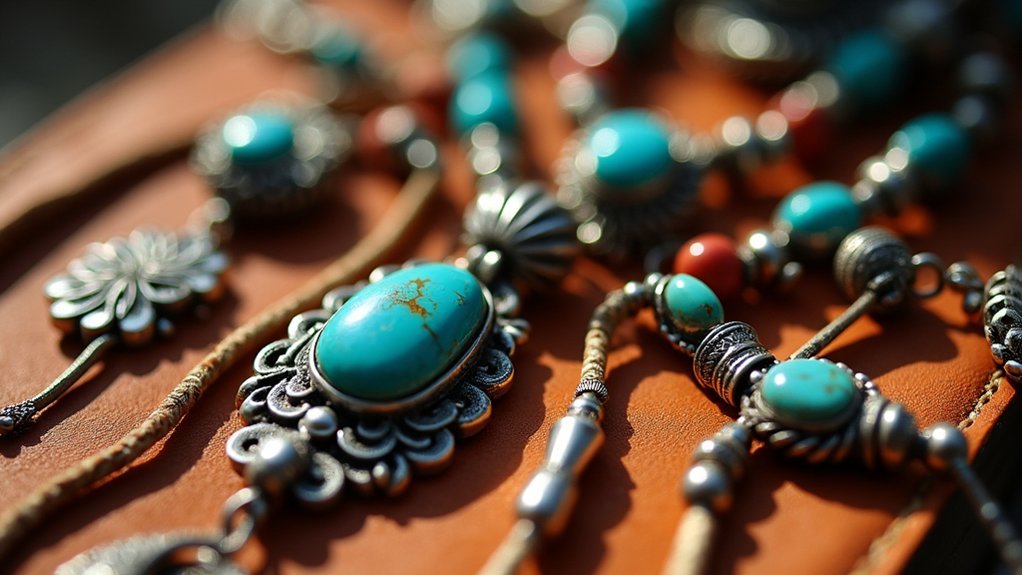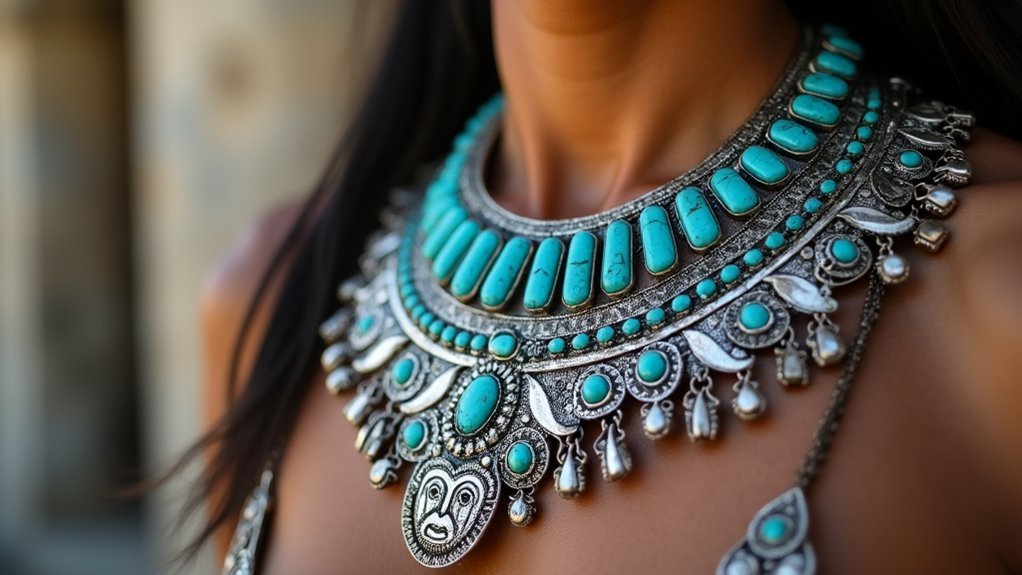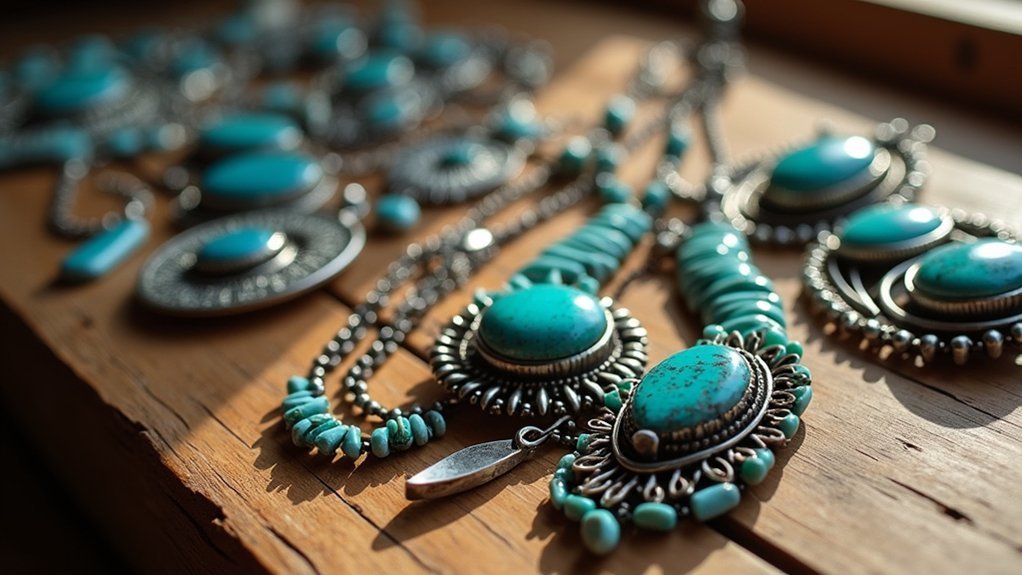Indigenous jewelry evolution reveals colonial impacts through these 7 markers: examine materials (pre-colonial bone/shell vs. colonial silver/turquoise), check craftsmanship techniques, observe design complexity, verify tribal symbols, note historical timeline indicators, assess wear patterns, and authenticate provenance. You’ll recognize authentic pieces by their blend of traditional motifs with European-introduced elements, while preserving cultural significance despite commercial pressures. These identification skills will transform your appreciation of these resilient cultural artifacts.
7 Tips: Indigenous Jewelry Under Colonial Influence

While Indigenous jewelry carries rich cultural heritage spanning thousands of years, understanding its evolution under colonial influence helps you appreciate the complex fusion of traditional and introduced elements.
When examining authentic Native American jewelry, notice how silver techniques—introduced during colonial periods—transformed tribal craftsmanship while maintaining cultural significance.
Look for pieces that showcase the balanced integration of turquoise (which gained prominence through European trade networks) with traditional Indigenous designs.
Authentic Indigenous jewelry marries ancestral designs with turquoise elements introduced through European trade, embodying cultural resilience through artistic adaptation.
Be wary of mass-produced “Native-inspired” jewelry lacking authentic connections to tribal aesthetics. Instead, seek work from Native artisans who consciously blend colonial influences with their cultural traditions.
The most valuable pieces often tell stories of resilience—how Indigenous craftspeople adapted foreign materials and techniques while preserving their artistic identity despite colonial pressures.
Identifying Pre-Colonial Vs Colonial-Influenced Design Elements
You’ll notice pre-colonial Indigenous jewelry primarily features natural materials like bone and shell, while colonial-influenced pieces incorporate European metals such as silver and gold.
The timeline of material adoption shows a clear shift from exclusively natural elements to combinations of traditional materials with newly introduced metals after European contact.
This evolution in materials parallels a transformation in symbolic meaning, as spiritually significant designs rooted in nature began to accommodate Western aesthetic preferences and commercial considerations.
Material Evolution Timeline
Through centuries of cultural exchange and adaptation, Indigenous jewelry underwent dramatic material transformations that tell the story of colonial contact and influence. When examining Native American jewelry, you’ll notice distinct material phases that reflect shifting cultural dynamics.
| Period | Primary Materials | Colonial Influence Level |
|---|---|---|
| Pre-1500s | Bone, shell, stone, copper | None |
| 1500s-1600s | + Glass beads, brass | Low |
| 1700s | + Silver, iron | Moderate |
| 1800s | Silver, turquoise dominance | High |
| Post-1880s | Refined silverwork, commercial turquoise | Integrated |
The evolution from natural materials to metal craftsmanship is particularly evident in Navajo jewelry, where early spiritual items transformed into elaborate silver and turquoise pieces. This timeline helps you identify authentic pre-colonial designs versus those showing European aesthetic influences.
Symbolic Meaning Shifts
As Indigenous jewelry evolved under colonial influence, the symbolic meanings embedded within each piece underwent profound transformation.
You’ll notice authentic Native American pieces carry deep connections to spiritual beliefs, while colonial-influenced designs often appropriated these elements without understanding their significance.
To identify authentic indigenous craftsmanship versus colonial-influenced pieces:
- Materials and techniques – Pre-colonial pieces feature natural elements (shells, bone, stone) with hand-crafted details, while colonial-influenced items incorporate imported glass beads and European metalworking methods.
- Symbolism behind motifs – Authentic pieces contain symbols with specific tribal meanings tied to nature, ancestors, and cosmology.
- Geometric precision – Colonial-influenced works often standardize and simplify traditional patterns, lacking the deliberate asymmetry that reflects natural world balance in genuine Indigenous designs.
Material Transformations: From Natural Resources to Imported Metals

You’ll see a stark contrast in Indigenous jewelry as silver, introduced by colonizers, replaced traditional shells and natural materials.
This shell-to-metal shift fundamentally altered artistic practices while creating new opportunities for cultural expression through silversmithing.
The colonial introduction of metals like silver didn’t just change materials—it transformed entire economies and artistic traditions as Native artisans, particularly the Navajo, developed sophisticated metalworking techniques that continue to influence their distinctive jewelry today.
Silver’s Colonial Impact
When Spanish colonizers arrived in the Southwest during the 16th century, they unwittingly sparked a profound transformation in Indigenous jewelry traditions by introducing silver.
You’ll find that Native American jewelry, particularly Navajo craftsmanship, evolved as artisans mastered European silversmithing techniques while infusing their own cultural aesthetics.
Silver’s colonial influence extended beyond mere decoration:
- It became a powerful status symbol and economic resource within Indigenous communities.
- It prompted the development of distinctive techniques like overlay work and concho designs.
- It created a meaningful fusion when combined with traditional materials like turquoise.
This metallic revolution transformed Indigenous adornment practices, as silver went from foreign material to central element in Native expression—a reflection of Indigenous adaptability and artistic resilience in the face of colonial contact.
Shell-to-Metal Transition
Prior to silver’s introduction, Indigenous adornment practices centered around natural materials abundant in their environments.
You’ll notice this fundamental shift when examining Native American jewelry collections, where shells and stones gradually gave way to silver beads and metalwork following European contact.
When trading with settlers began, Indigenous artisans quickly mastered silversmithing techniques, incorporating their traditional motifs into new metal forms.
This change wasn’t merely aesthetic—it transformed economic relationships as artisans created marketable pieces that appealed to non-Native buyers while preserving their Indigenous heritage.
What makes these pieces particularly significant is how they represent cultural resilience.
Despite adopting new materials like silver, tribes maintained their distinctive artistic expressions.
Today’s turquoise jewelry exemplifies this beautiful fusion, where ancestral designs continue to thrive through adapted materials and techniques.
Adapting Traditional Techniques to New Colonial Trade Goods
Three distinct pathways emerged as Indigenous artisans adapted their traditional jewelry techniques to incorporate colonial trade goods. Native American jewelry transformed as artisans mastered silversmithing after Spanish colonizers introduced silver, creating iconic pieces like Navajo conchos and squash blossom necklaces.
You’ll notice these adaptations reflected in:
- Tool evolution – New European tools enabled more intricate designs while preserving traditional motifs.
- Material integration – Turquoise stones gained prominence alongside glass beads and metals, creating symbolic connections between heritage and economic realities.
- Economic adaptation – Traditional techniques merged with colonial materials, allowing Indigenous jewelry to enter broader trade networks.
This creative adaptation didn’t just produce beautiful jewelry—it helped sustain Native communities by creating marketable art that maintained cultural integrity while embracing new economic opportunities.
Symbolism Preservation Despite External Pressures

Despite relentless colonial pressures to assimilate, Indigenous jewelry artisans maintained powerful symbolic traditions while adapting to new materials and techniques. You’ll find this resilience embodied in symbols like the Thunderbird and Sunface that continued to represent strength, protection, and harmony in jewelry pieces, even as European influences introduced silversmithing and overlay techniques.
When you examine authentic Indigenous jewelry, notice how artisans masterfully incorporated turquoise and other sacred stones, preserving their spiritual significance while working with colonial-introduced metals. This preservation wasn’t accidental—it represented deliberate resistance to cultural erasure.
Tribal narratives embedded in these designs served as cultural memory keepers, allowing communities to maintain their identity under colonial influence. These symbolic elements weren’t merely decorative but carried ancestral knowledge through generations despite external pressures to abandon traditional ways.
Economic Shifts in Indigenous Jewelry Production
When European colonizers arrived, they unknowingly triggered a profound economic transformation in Indigenous jewelry production that would reshape cultural practices for generations.
You’ll notice these economic shifts reflected in authentic Native jewelry as artisans adapted to new markets and materials.
The evolution of Navajo Silver work exemplifies how trade relationships fundamentally altered traditional crafting economies:
- Market Access – Native American artists gained unprecedented commercial opportunities, shifting jewelry from purely cultural artifacts to income-generating goods.
- Material Innovation – European silver and trade beads integrated into Indigenous designs, creating distinctive hybrid styles still valued today.
- Commodification Impact – Tourist demand drove increased production but threatened traditional practices as mass-produced imitations began competing with authentic pieces.
These economic transformations permanently altered Indigenous jewelry traditions, creating both opportunities and challenges for artisans.
Authentication Methods for Historical Indigenous Pieces

As colonial market forces transformed Indigenous jewelry from cultural artifacts into commercial products, distinguishing authentic historical pieces from imitations became increasingly important.
When authenticating ceremonial pieces, look for natural wear patterns indicating actual ritual use rather than artificial aging.
Check for proper tribal affiliation markers—authentic jewelry typically includes the artist’s name and tribal identification.
Examine the craftsmanship closely; genuine items showcase traditional techniques like intricate silversmithing or detailed beadwork that mass-produced versions rarely capture.
For verification, consult Indigenous artists or reputable dealers who understand the historical context of these pieces.
Finally, investigate the provenance of the jewelry—knowing who owned it previously and how it was created provides essential authentication evidence.
Well-documented history often separates genuine cultural treasures from commercial reproductions.
Frequently Asked Questions
Is It Okay for a White Person to Wear Native American Jewelry?
Yes, you can wear Native American jewelry respectfully by purchasing directly from Indigenous artists. This supports their communities, honors their craftsmanship, and shows appreciation rather than appropriation of their cultural heritage.
What Is the Significance of Jewelry in Native American Culture?
In Native American culture, you’ll find jewelry isn’t just decorative—it’s your connection to heritage, spirituality, and community. You’re wearing stories, protection, and tribal identity when adorned with these meaningful pieces.
Can White People Wear Squash Blossom Necklaces?
You can wear squash blossom necklaces if you purchase from Native artisans and understand their cultural significance. Support Indigenous creators, avoid mass-produced imitations, and approach the tradition with respect rather than as a fashion trend.
What Are the Two Categories of Native American Jewelry?
The two categories of Native American jewelry are traditional and contemporary. You’ll recognize traditional pieces by ancestral techniques and cultural symbolism, while contemporary jewelry blends modern aesthetics with Native heritage in innovative ways.
In Summary
When you’re exploring indigenous jewelry, remember that each piece tells a complex story of resilience. You’ll see how cultural traditions persisted while adapting to colonial pressures. Don’t just appreciate the aesthetic beauty—understand the historical context that shaped these treasures. By recognizing both traditional elements and colonial influences, you’re honoring the complete narrative of indigenous artistic expression and its ongoing evolution.





Leave a Reply